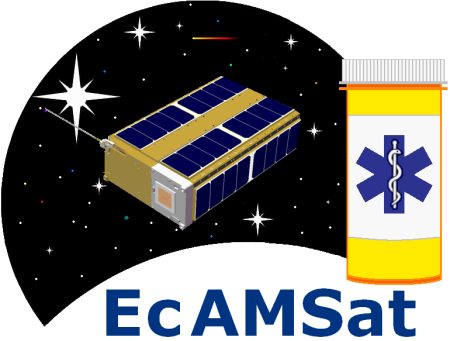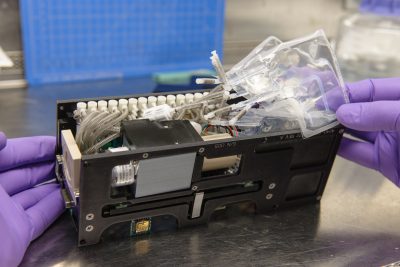EcAMSAT (OA-8)
E. coli AntiMicrobial Satellite
The E. coli AntiMicrobial Satellite (EcAMSat) will be transported to the International Space Station aboard the OA-8 flight. EcAMSat will then be deployed into space from the ISS. This newly-developed nanosatellite houses an experiment that will test the antibiotic resistance of bacteria in space. The space environment has been shown to decrease host immune response and increase bacterial antibiotic resistance, making infection a potential risk for future longer-duration spaceflights. By quantifying the antibiotic response of E. coli in space and contributing to a better understanding of the underlying genetic mechanism, this research could help with designing countermeasures to protect the health of future astronauts.
EcAMSat, which uses nanosatellite technology demonstrated on previous Ames missions, is an entirely autonomous satellite. Like other nanosatellites, its major advantage is its small size (about as big as a large box of cereal), which means that relatively little fuel is needed to get it into orbit. It will track bacterial growth using optical sensing and alamarBlue, a dye that changes color in response to enzymes generated by cellular metabolic processes. Two strains of E. coli, one a wild-type and one a mutant strain with a stress response gene deleted, will be launched in 48 microfluidic wells aboard the nanosatellite. The first phase of the experiment will be to introduce new media to the cells and allow them to reproduce for 48 hours. After this period, the newly grown cells in each well will be challenged for 48 hours with either an antibiotic solution in one of three different concentrations or a no-antibiotic control solution. Bacterial metabolism will then be tracked for another 48 hours using light absorbance after introduction of the color-changing dye, alamarBlue, which will allow assessment of the change in antibiotic resistance of each E. coli strain in response to the space environment. Throughout the experiment, data on bacterial health and experimental conditions such as temperature will be transmitted back to Earth via satellite telemetry, so that researchers can track the experiment’s progress in near real-time.
This experiment will help improve our understanding of bacterial resistance, which is an important topic both on Earth, where resistance to antibiotics is a growing problem, and in space, where astronauts need to be able to care for their own health with little or no support from the ground. In particular, this experiment will help untangle the genetic and functional basis of antibacterial resistance in E. coli. The mutant strain of E. coli which will be used in the experiment lacks sigma S, a protein important in regulating stress responses, including antibiotic resistance. If, as expected, the wild type strain has increased antibiotic resistance in space compared to its counterpart on the ground, and the mutant strain shows less of a difference than the wild type strain in antibiotic resistance in space versus on the ground, this will increase our understanding of the genetic basis of antibiotic resistance, helping drive forward efforts to combat this difficult problem.
Project Manager: Stevan Spremo, NASA Ames Research Center
Mission Scientist: Matthew Lera, KBRwyle FILMSS, NASA Ames Research Center
Principal Investigator: A.C. Matin, Ph.D., Stanford University School of Medicine
Learn More
Read the story: NASA is sending e coli to space for astronaut health
For more information, see the Space Station Research Explorer about EcAMSat.
Author: Yael Kisel






























